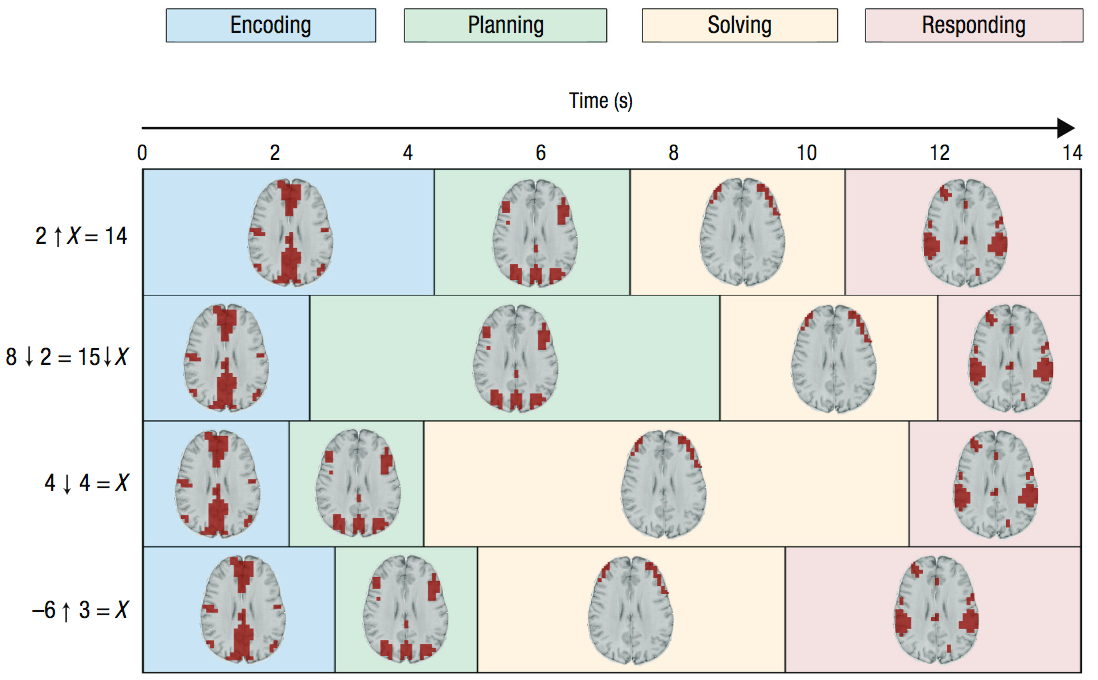Distinct stages of thinking revealed by brain activity patterns
July 22, 2016

Durations of four stages associated with problem solving and corresponding MRI images. In the four example problems (left), the arrows denote new mathematical operators that participants had learned. Color coding reflects the durations of the stages. (credit: John R. Anderson et al./Psychological Science)
Using neuroimaging data, Carnegie Mellon University researchers have identified four distinct stages of math problem solving, according to a new study published in the journal Psychological Science.
“How students were solving these kinds of problems was a total mystery to us until we applied these techniques,” says psychological scientist John Anderson, lead researcher on the study. “Now, when students are sitting there thinking hard, we can tell what they are thinking each second.”
Insights from this work may eventually be applied to the design of more effective classroom instruction, says Anderson.
Combining pattern analysis and hidden semi-Markov models
Anderson combined two analytical approaches — multivoxel pattern analysis (MVPA) and hidden semi-Markov models (HSMM) — to shed light on the different stages of thinking. MVPA has typically been used to identify momentary patterns of activation; adding HSMM, Anderson hypothesized, would yield information about how these patterns play out over time.
The researchers applied this combined approach to neuroimaging data collected from participants as they solved specific types of math problems. To gauge whether the stages that were identified mapped on to actual stages of thinking, the researchers manipulated different features of the math problems; some problems required more effort in coming up with an appropriate solution plan and others required more effort in executing the solution.
The aim was to test whether these manipulations had the specific effects one would expect on the durations of the different stages.
Stages of cognition
The researchers identified four stages of cognition: encoding, planning, solving, and responding. The planning stage tended to be longer when the problem required more planning, and the solution stage tended to be longer when the solution was more difficult to execute, indicating that the method mapped onto real stages of cognition that were differentially affected by various features of the problems.
“Typically, researchers have looked at the total time to complete a task as evidence of the stages involved in performing that task and how they are related,” says Anderson. “The methods in this paper allow us to measure the stages directly.”
Although the study focused specifically on mathematical problem solving, the method holds promise for broader application, the researchers argue. Using the same method with brain imaging techniques that have greater temporal resolution, such as EEG, could reveal even more detailed information about the various stages of cognitive processing.
This work was supported by a National Science Foundation grant and by a James S. McDonnell Foundation Scholar Award.
Abstract of Hidden Stages of Cognition Revealed in Patterns of Brain Activation
To advance cognitive theory, researchers must be able to parse the performance of a task into its significant mental stages. In this article, we describe a new method that uses functional MRI brain activation to identify when participants are engaged in different cognitive stages on individual trials. The method combines multivoxel pattern analysis to identify cognitive stages and hidden semi-Markov models to identify their durations. This method, applied to a problem-solving task, identified four distinct stages: encoding, planning, solving, and responding. We examined whether these stages corresponded to their ascribed functions by testing whether they are affected by appropriate factors. Planning-stage duration increased as the method for solving the problem became less obvious, whereas solving-stage duration increased as the number of calculations to produce the answer increased. Responding-stage duration increased with the difficulty of the motor actions required to produce the answer.